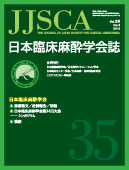Volume 35, Issue 5
Displaying 1-22 of 22 articles from this issue
- |<
- <
- 1
- >
- >|
Original Articles
-
2015Volume 35Issue 5 Pages 567-572
Published: September 15, 2015
Released on J-STAGE: October 26, 2015
Download PDF (324K) -
2015Volume 35Issue 5 Pages 573-578
Published: September 15, 2015
Released on J-STAGE: October 26, 2015
Download PDF (398K) -
2015Volume 35Issue 5 Pages 579-584
Published: September 15, 2015
Released on J-STAGE: October 26, 2015
Download PDF (293K)
Case Reports
-
2015Volume 35Issue 5 Pages 585-588
Published: September 15, 2015
Released on J-STAGE: October 26, 2015
Download PDF (541K) -
2015Volume 35Issue 5 Pages 589-594
Published: September 15, 2015
Released on J-STAGE: October 26, 2015
Download PDF (679K) -
2015Volume 35Issue 5 Pages 595-600
Published: September 15, 2015
Released on J-STAGE: October 26, 2015
Download PDF (911K) -
2015Volume 35Issue 5 Pages 601-606
Published: September 15, 2015
Released on J-STAGE: October 26, 2015
Download PDF (752K) -
2015Volume 35Issue 5 Pages 607-610
Published: September 15, 2015
Released on J-STAGE: October 26, 2015
Download PDF (478K)
Brief Reports
-
2015Volume 35Issue 5 Pages 611-614
Published: September 15, 2015
Released on J-STAGE: October 26, 2015
Download PDF (550K)
Symposium (1)
-
2015Volume 35Issue 5 Pages 615
Published: September 15, 2015
Released on J-STAGE: October 26, 2015
Download PDF (135K) -
2015Volume 35Issue 5 Pages 616-621
Published: September 15, 2015
Released on J-STAGE: October 26, 2015
Download PDF (538K) -
2015Volume 35Issue 5 Pages 622-630
Published: September 15, 2015
Released on J-STAGE: October 26, 2015
Download PDF (530K)
Symposium (2)
-
2015Volume 35Issue 5 Pages 631
Published: September 15, 2015
Released on J-STAGE: October 26, 2015
Download PDF (140K) -
2015Volume 35Issue 5 Pages 632-642
Published: September 15, 2015
Released on J-STAGE: October 26, 2015
Download PDF (1273K) -
2015Volume 35Issue 5 Pages 643-650
Published: September 15, 2015
Released on J-STAGE: October 26, 2015
Download PDF (1081K) -
2015Volume 35Issue 5 Pages 651-659
Published: September 15, 2015
Released on J-STAGE: October 26, 2015
Download PDF (875K)
Symposium (3)
-
2015Volume 35Issue 5 Pages 660
Published: September 15, 2015
Released on J-STAGE: October 26, 2015
Download PDF (147K) -
2015Volume 35Issue 5 Pages 661-667
Published: September 15, 2015
Released on J-STAGE: October 26, 2015
Download PDF (1119K) -
2015Volume 35Issue 5 Pages 668-672
Published: September 15, 2015
Released on J-STAGE: October 26, 2015
Download PDF (628K) -
2015Volume 35Issue 5 Pages 673-678
Published: September 15, 2015
Released on J-STAGE: October 26, 2015
Download PDF (1248K)
Lectures
-
2015Volume 35Issue 5 Pages 679-685
Published: September 15, 2015
Released on J-STAGE: October 26, 2015
Download PDF (994K) -
2015Volume 35Issue 5 Pages 686-693
Published: September 15, 2015
Released on J-STAGE: October 26, 2015
Download PDF (890K)
- |<
- <
- 1
- >
- >|
